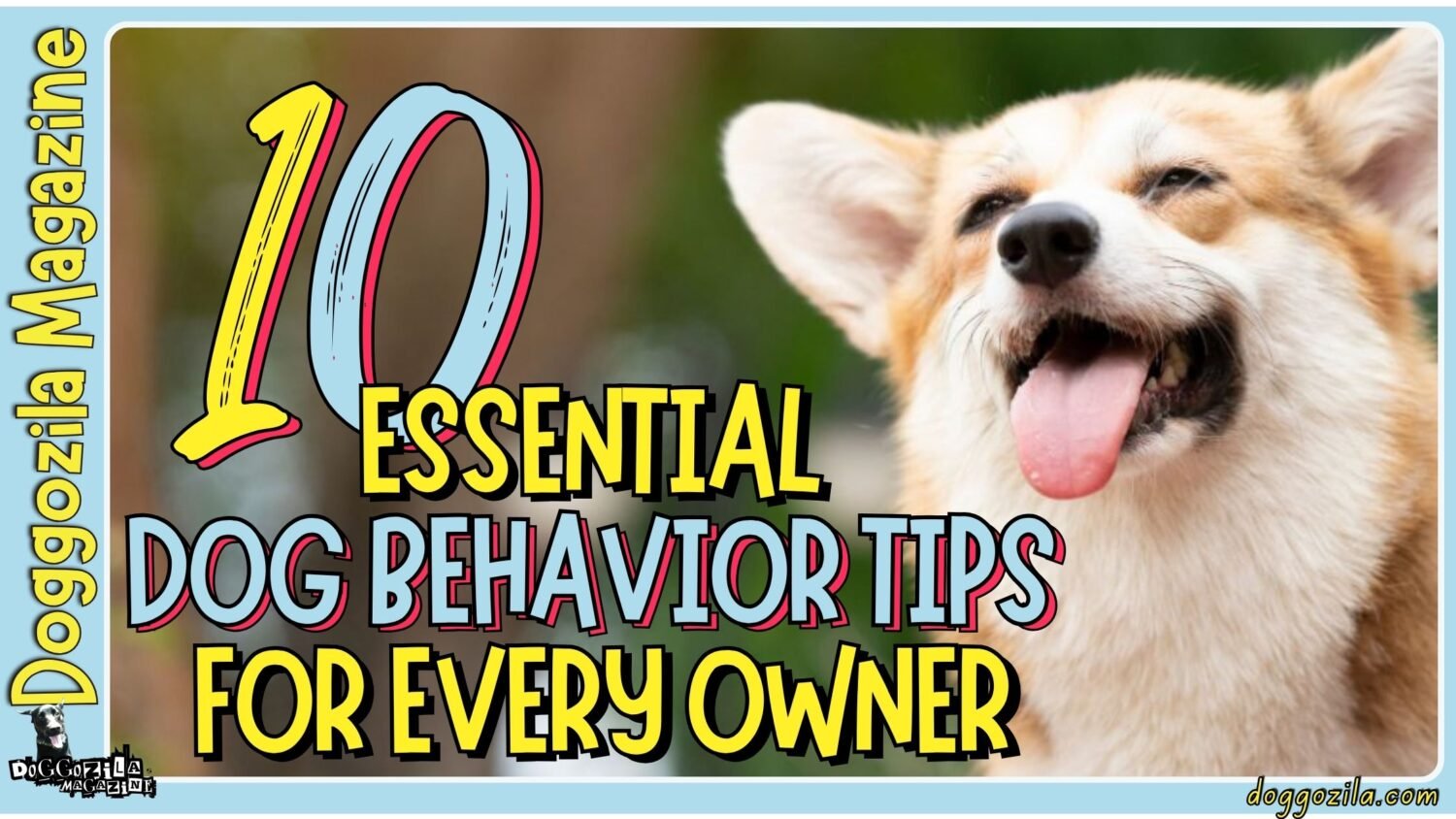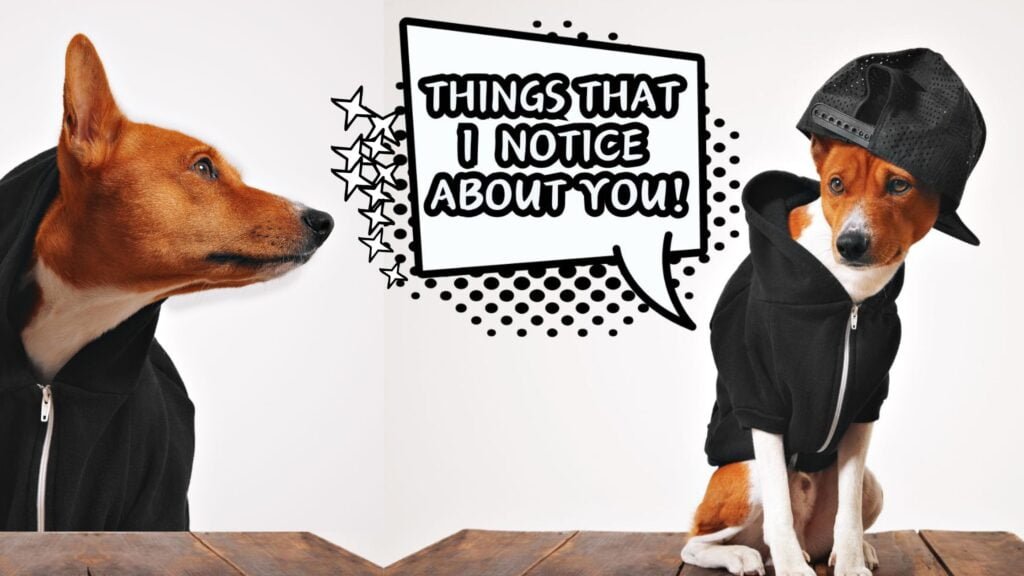Forget boring fetch sessions! Imagine the scene: your dog, ears flapping in the breeze, paws confidently planted, cruising down the sidewalk on a skateboard. It’s not just a viral video dream – to teach your dog to ride a skateboard is an achievable, incredibly epic and fun adventure that strengthens your bond and turns heads. It combines canine athleticism, trust-building, and pure, unadulterated joy.
This guide will show you the stages and commands to teach your dog how to ride a skateboard, transforming sidewalk strolls into radical rides. Get ready for tail wags, triumphant barks, and the coolest trick in the neighborhood!

GEARING UP: ESSENTIAL PREP WORK BEFORE YOU DISCOVER HOW TO TEACH YOUR DOG TO SKATEBOARD
Before your pup hits the pavement, laying the groundwork is crucial for safety and success. This phase is less about the board and more about building confidence, basic obedience, and selecting the right environment. Rushing in can lead to fear or frustration, derailing your skate dreams before they start. Setting the stage properly makes the actual skateboarding introduction smoother and way more fun.
Assessing Your Pup’s Suitability: Is Skateboarding Right for Them?
Not every dog is destined for the X-Games, and that’s perfectly okay! Seriously consider your dog’s breed, age, size, temperament, and physical health. High-energy, confident breeds like Border Collies, Jack Russells, or Staffordshire Bull Terriers often excel, but motivated mutts can be stars too.
Crucial point: to teach your dog how to ride a skateboard begins with ensuring they can physically handle it. Puppies under a year old, seniors dogs with arthritis, brachycephalic breeds (like Pugs or Bulldogs), or dogs with joint issues should probably sit this one out – consult your vet if unsure. Temperament matters immensely; a dog easily spooked by noise or movement might find skateboarding overwhelming.
Gauge their confidence by observing their reaction to novel objects and surfaces. The foundation of how to teach your dog to skateboard is a willing, able, and enthusiastic participant. Start by building their confidence with wobble boards or balance cushions if needed. Remember, forcing a fearful dog is counterproductive and unfair; the goal is joyful partnership, not stress.
Building the Foundation: Obedience Commands You Absolutely Need
Rock-solid basic obedience isn’t just helpful; it’s non-negotiable for safety and control during skate sessions. Mastering commands like “Sit,” “Stay,” “Come,” “Leave it,” and especially “Off” is paramount before the board even comes out.
Think about it: you need your dog to reliably “Stay” while you position the board, “Come” immediately if they start heading towards traffic, and “Off” instantly if they lose control. How to teach your dog to skateboard seamlessly integrates these commands into every step.
Practice these commands in increasingly distracting environments to ensure they’re bombproof. Incorporate impulse control games – teaching your dog to wait patiently for a treat or toy builds the focus needed when the exciting skateboard appears. A strong “Watch me” or “Focus” command is golden for redirecting their attention back to you amidst distractions.
This groundwork makes the actual skateboarding process infinitely smoother and safer; you’re not just teaching a trick, you’re managing an activity with potential momentum. Consistent practice of these basics is the unsung hero to teach your dog how to ride a skateboard.
Choosing the Paw-fect Skateboard and Safety Dog Gear: No Teach Compromises!
Not all skateboards are created equal, especially for dog riders. Opt for a high-quality, stable cruiser or longboard with softer, larger wheels (around 78A-87A durometer) – these provide a smoother ride over cracks and pebbles and offer more stability than hard, small skatepark wheels. Wider decks (8.5 inches or more) give your dog more room to plant their paws securely.
Avoid cheap, flimsy boards; a snapped deck mid-roll is terrifying. Grip tape is essential, but ensure it’s not overly abrasive for delicate paw pads (some owners add thin traction pads). Safety is non-negotiable: a well-fitting harness (never a collar!) provides secure control without neck strain.
Consider protective gear like durable booties if skating on hot pavement or rough terrain. A dog helmet might seem extreme, but for ambitious tricks or high speeds, it’s worth considering. Finding the right equipment tailored for canine comfort and stability is a fundamental step to teach your dog how to ride a skateboard effectively and safely. Invest wisely; your dog’s confidence depends on it.
🔑 Key Points: Success hinges on thorough preparation. Assess your dog’s breed, age, health, and temperament for suitability. Master essential obedience commands (“Sit,” “Stay,” “Come,” “Off”) in distracting environments before introducing the board. Invest in a stable, dog-appropriate skateboard (wide deck, soft wheels) and prioritize safety gear like a secure harness, considering booties or a helmet for ambitious pups.

FIRST TEACH ENCOUNTERS: INTRODUCING THE SKATEBOARD TO YOUR DOG AND BUILDING POSITIVE ASSOCIATIONS
The skateboard is a weird, noisy, moving object – naturally suspicious to most dogs! This stage is all about transforming that suspicion into curiosity and excitement. Patience and positive reinforcement are your superpowers here. We’re building positive associations, not forcing interaction. Let your dog set the pace.
Making the Skateboard a Friend, Not a Foe: Desensitization Techniques to Teach your Dog
Start with the board completely stationary in a familiar, quiet room. Simply place it on the ground and ignore it yourself. Let your dog investigate it in their own time, at their own pace. Toss incredibly high-value treats (think chicken, cheese, hot dog bits) near the board, then gradually closer, and eventually on the stationary board, rewarding any calm investigation or even just looking at it without fear.
Clicker training is excellent here – mark the exact moment they show calm curiosity or touch it with their nose. If they startle or bark, calmly remove the pressure; increase distance or put the board away and try later. Never force them near it. Repeat short, positive sessions multiple times a day.
The goal is for the board’s presence to predict amazing treats, making it a welcome sight. This foundational desensitization is arguably the most critical phase in how to teach your dog to skateboard successfully. Rushing this step can create lasting fear. Celebrate tiny victories – a sniff is a win! Keep sessions upbeat and end before your dog gets bored or stressed.
Rewarding Curiosity: Clicker Training and Treat Placement Magic
Once your dog is comfortable with the stationary board, it’s time to strategically use rewards to shape specific behaviors. Use your clicker (or a consistent marker word like “Yes!“) to capture and reward any interaction you want to encourage. Click and treat for looking at the board, sniffing it, touching it with a paw, or standing near it.
Start placing treats strategically: first on the ground beside the board, then on the edge of the deck, then progressively further onto the deck. Encourage them to place one paw, then two paws on the stationary board using a lure (a treat guided over the board) or by placing treats just out of reach on the deck. How to teach your dog to skateboard relies heavily on making stepping onto that deck a highly rewarding choice.
If they put two paws on, jackpot! Throw a mini party. Never punish fear or avoidance; simply go back a step. Make climbing onto the stationary board the most rewarding game ever. This builds the physical confidence and positive association needed before anything moves. Be patient; some dogs master this quickly, others need days or weeks. Celebrate every paw placement!
🔑 Key Points: Transform the skateboard from a scary object into a source of joy. Use patient desensitization: let your dog investigate the stationary board at their own pace, pairing its presence with high-value treats. Clicker training and strategic treat placement on the board are powerful tools to reward curiosity and build positive associations, laying the critical foundation for all future steps.

FINDING THEIR STANCE: MASTERING BALANCE ON A STATIONARY BOARD
Before the wheels roll, your dog needs to feel rock-solid just standing on the board. This stage develops their core strength, balance, and comfort with the feeling of being elevated on a potentially wobbly surface. Think of it as skateboard yoga for dogs!
The “Place” Command and Paw Positioning: Building Core Stability
Leverage the “Place” command (or “Board” or “On“) you’ve ideally started teaching during treat placement. Encourage your dog to place all four paws on the stationary board using a lure or pointing. Reward heavily for a calm, balanced stand. Pay attention to their natural stance – some dogs prefer front paws together, others a wider stance; let them find what feels stable.
Initially, they might only manage a second or two. Click and reward for increasing duration of calm standing. Gently praise calm behavior; excessive excitement can make them jump off. How to teach your dog to skateboard effectively requires this static balance foundation.
Always Practice in Safe Environment
You can introduce very subtle movement once they’re solid: gently wiggle the board side-to-side (an inch or less) while they’re on it, rewarding them heavily for staying put and adjusting their weight. This mimics the micro-movements of a rolling board.
Practice near a wall or couch they can lightly brace against if needed for confidence, but aim for independence. Core engagement is key – you might see their abdominal muscles tense as they balance. Build duration slowly; aim for 10-15 seconds of solid, relaxed standing. This phase builds crucial physical awareness and trust.
Introducing Micro-Movements: Wobble Boards and Controlled Tilts
Once your dog is confident standing still, it’s time to simulate the board’s potential instability. A dedicated dog wobble/cuddle board (a board on a central fulcrum) is a fantastic intermediate tool. Start with it nearly flat, rewarding standing. Gradually increase the tilt angle very slowly as your dog gains confidence, rewarding them for shifting their weight to stay balanced.
If you don’t have a wobble board, place the skateboard on a slightly unstable surface like thick carpet, grass, or a yoga mat to create minor, dampened movement. You can also very gently and slowly rock the stationary skateboard back and forth (truck tilts) or side-to-side with your hand while they stand, clicking and treating for maintaining balance. Keep these movements minimal and predictable at first.
The goal isn’t to scare them, but to teach them how to use their body to counter small shifts. How to teach your dog to skateboard safely involves mastering these small destabilizations before encountering real momentum. Watch their body language closely; stop if they show stress. Make it a game – balance equals chicken! This builds the neuromuscular coordination vital for riding.
🔑 Key Points: Balance is non-negotiable before rolling. Use the “Place” command to encourage your dog to stand calmly with all four paws on the stationary board, rewarding duration. Introduce micro-movements using a wobble board or by gently rocking the stationary skateboard itself. This builds core strength, body awareness, and confidence in managing instability, mimicking the feel of a moving board.
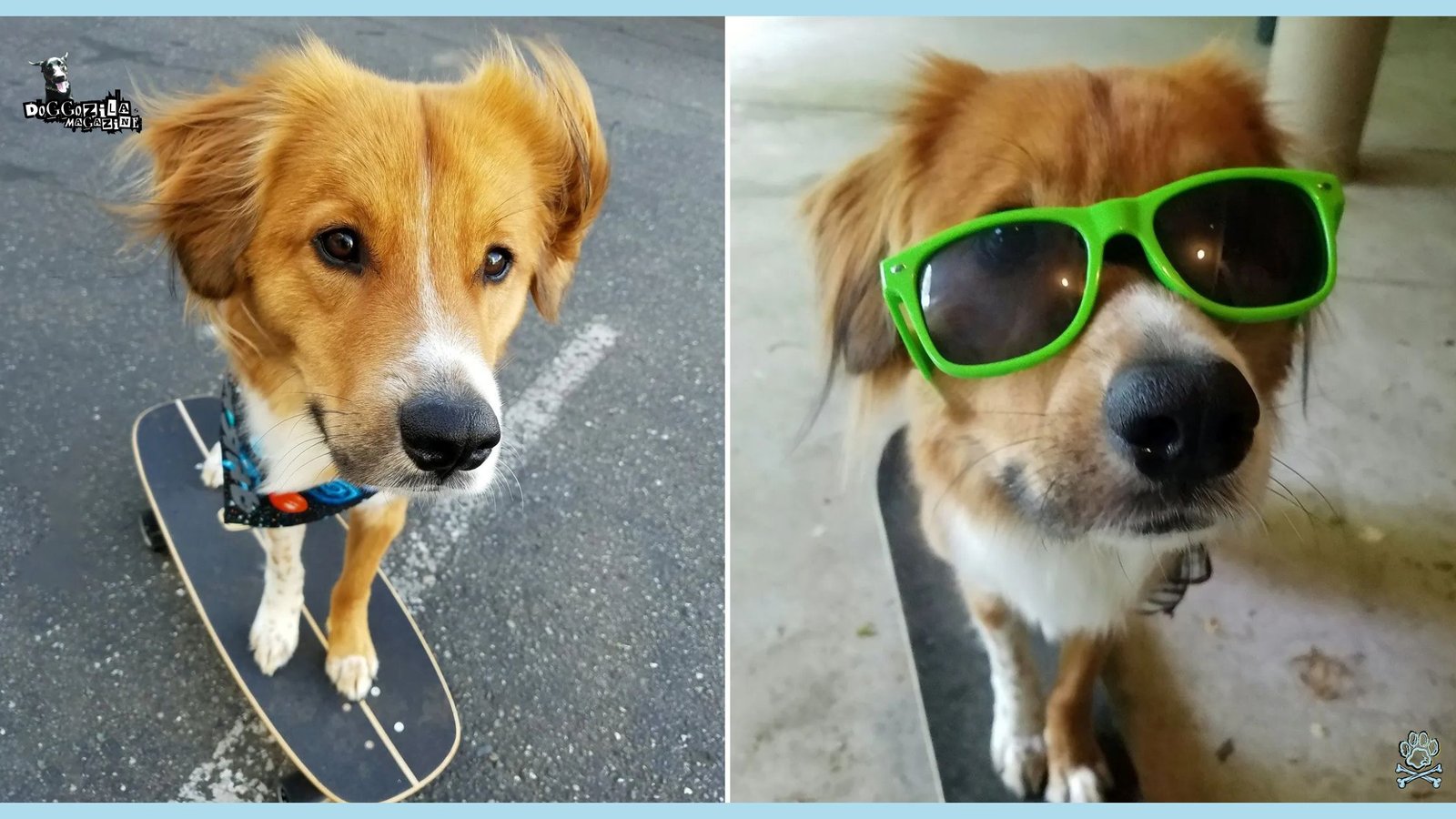
THE BIG MOMENT: HOW TO TEACH YOUR DOG TO SKATEBOARD WITH GENTLE PROPULSION
This is where the magic starts! We’re introducing forward motion, but in the gentlest, most controlled way possible. Momentum is the new variable, and we need to make it exciting, not frightening. Forget pushing them; we’re luring and guiding.
Luring vs. Gentle Pushing: Why Patience Wins Every Time
The cardinal rule: NEVER forcefully push your dog while they’re on the skateboard. This is a recipe for fear, wipeouts, and shattered trust. Instead, use high-value luring. With your dog standing balanced on the stationary board, hold an irresistible treat just in front of their nose.
Slowly lure them forward, encouraging them to shift their weight and cause the board to roll under their own power, even just an inch. Click and reward instantly for any forward movement they initiate. How to teach your dog to skateboard humanely revolves around them choosing to move the board.
Start on a very slight, smooth downhill slope (like a gentle driveway) or on a smooth, flat surface where even a tiny weight shift causes a small roll. Grass can be great for initial rolls as it provides gentle resistance. If they jump off, calmly reset them and try again.
Celebrate microscopic rolls! The key is that they make it happen. This self-propelled movement builds confidence and understanding of cause-and-effect. Pushing them removes their agency and control, often leading to panic. Luring keeps them focused forward and engaged.
Choosing the Perfect Practice Terrain: Slope, Surface, and Space
Location is critical for these first rolls. Seek out smooth, paved surfaces free of debris, cracks, or traffic. A quiet tennis court, basketball court, or smooth garage floor is ideal. Grass is excellent for ultra-slow, controlled initial attempts as it significantly dampens speed and provides a softer landing.
A very slight, consistent incline can provide just enough natural momentum for them to experience rolling without you needing to lure aggressively – think the gentlest slope imaginable. How to teach your dog to skateboard safely requires managing speed meticulously at this stage. Avoid steep hills or long runways until they are expert stoppers!
Ensure you have plenty of open space around them in case they bail out. The surface should offer some grip but not so much that the board won’t roll at all. Test the slope yourself first – if you place the board and it rolls away quickly, it’s too steep for learning. The perfect beginner spot makes those first few inches of self-propelled roll achievable and rewarding. Safety and confidence come first.
🔑 Key Points: Initiate motion through self-propulsion, never pushing. Use high-value luring just in front of your dog’s nose while they stand balanced, encouraging them to shift their weight and cause the board to roll forward even an inch. Choose safe, smooth terrain like short gentle slopes, grass (for slow speed), or quiet courts, ensuring minimal speed and maximum control for these first rolls.
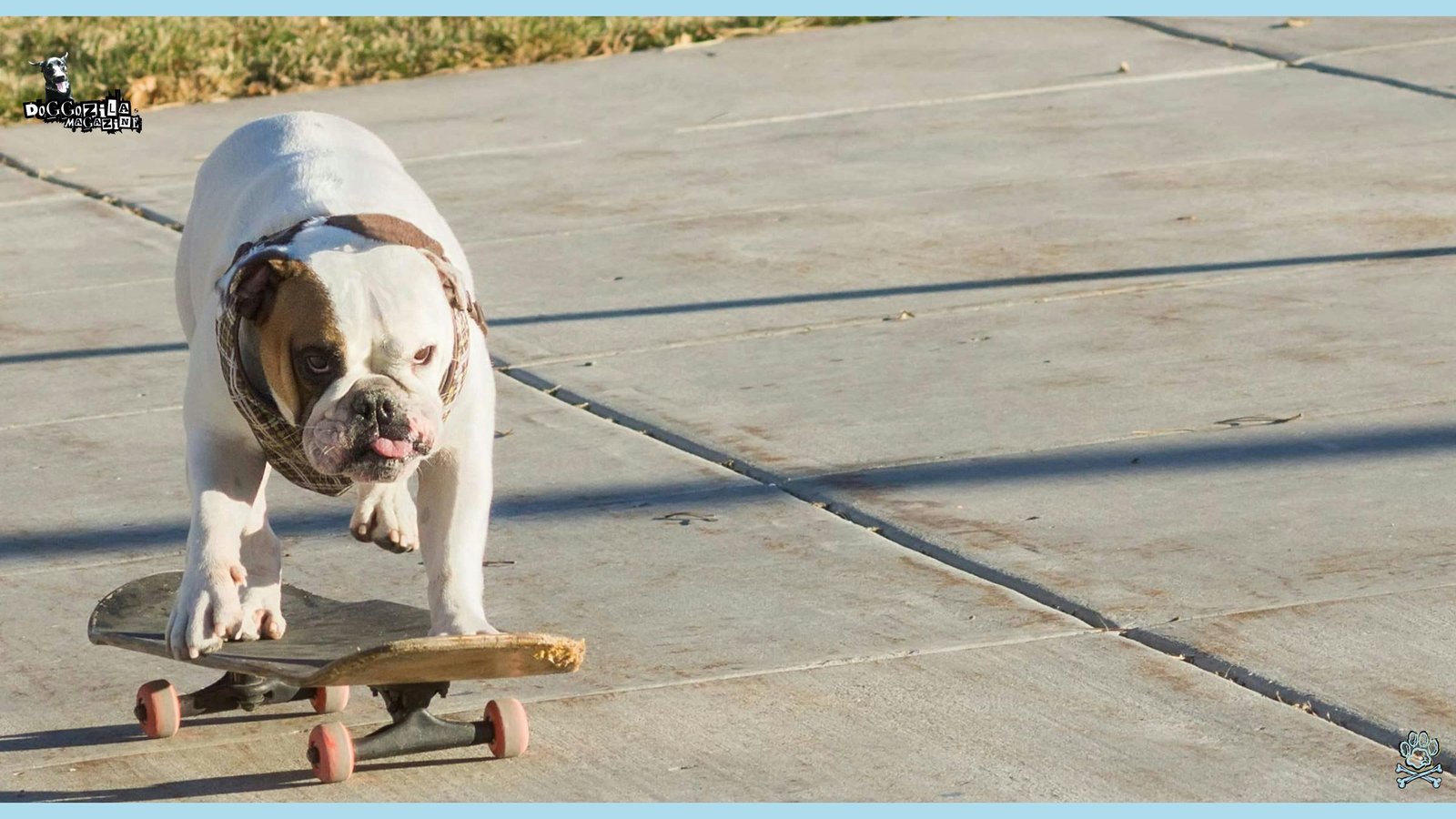
ROLLING SOLO: HOW TO TEACH YOUR DOG TO SKATEBOARD INDEPENDENTLY
They’ve taken those first tentative rolls! Now we build distance, consistency, and the holy grail: independent riding. This phase transitions them from needing constant luring to understanding how to propel and balance themselves for longer stretches. It’s about fading your prompts and letting their skills shine.
Fading the Lure and Increasing Distance: Building Momentum Confidence
You’ve used luring to get those initial movements. Now, gradually make the lure less obvious. Start by holding the treat lure further away after they start moving, encouraging them to roll a bit further to reach it. Then, start using an empty hand motion mimicking the lure, followed immediately by delivering the treat from your other hand once they complete the motion.
So, to teach your dog how to ride a skateboard independently involves systematically replacing the physical lure with a hand signal, then potentially just a verbal cue (“Go!” or “Skate!”). Start asking for slightly longer rolls before clicking and treating. If they stop midway, resist luring again immediately; sometimes a gentle verbal encouragement or pat on the side is enough to get them going.
Work on smooth, straight-line rolling for increasing distances (a few feet, then several feet). Practice on flat ground and very gentle slopes. Celebrate longer rolls enthusiastically! The goal is for them to understand that shifting their weight forward keeps the board moving. Keep sessions short and end on a high note – quitting while they’re still eager keeps motivation sky-high.
Mastering the Straight Line: Steering Corrections and Weight Shifting
Initially, dogs often wiggle or veer off course. Gently guide them back straight using your body position or light leash guidance (if using a harness with a handle). Practice in wide-open spaces initially. Observe their natural stance – subtle shifts in their shoulder or hip weight can cause turns. To teach your dog how to ride skateboard straight involves helping them find a stable, centered posture.
You can place visual targets (like a cone or a specific crack in the pavement) a short distance away for them to aim for, rewarding successful straight runs to the target. If they consistently lean one way, check if the surface is uneven or if they have a physical preference. Very minor, gentle leash cues during the roll can help correct drift, but focus primarily on rewarding straight-line success.
As they gain confidence, they’ll naturally learn to make micro-adjustments to stay upright and on track. This phase is about refining control and building their understanding of how their body position affects the board’s direction. Patience is key; smooth, straight rolling takes practice.
🔑 Key Points: Transition from lured movement to independent riding. Gradually fade the physical lure, replacing it with a hand signal and then a verbal cue (“Go!”, “Skate!”). Systematically increase the distance of straight-line rolls, rewarding longer stretches. Gently guide them back straight if they veer, using body position or light leash cues, and help them understand how weight shifting affects direction.
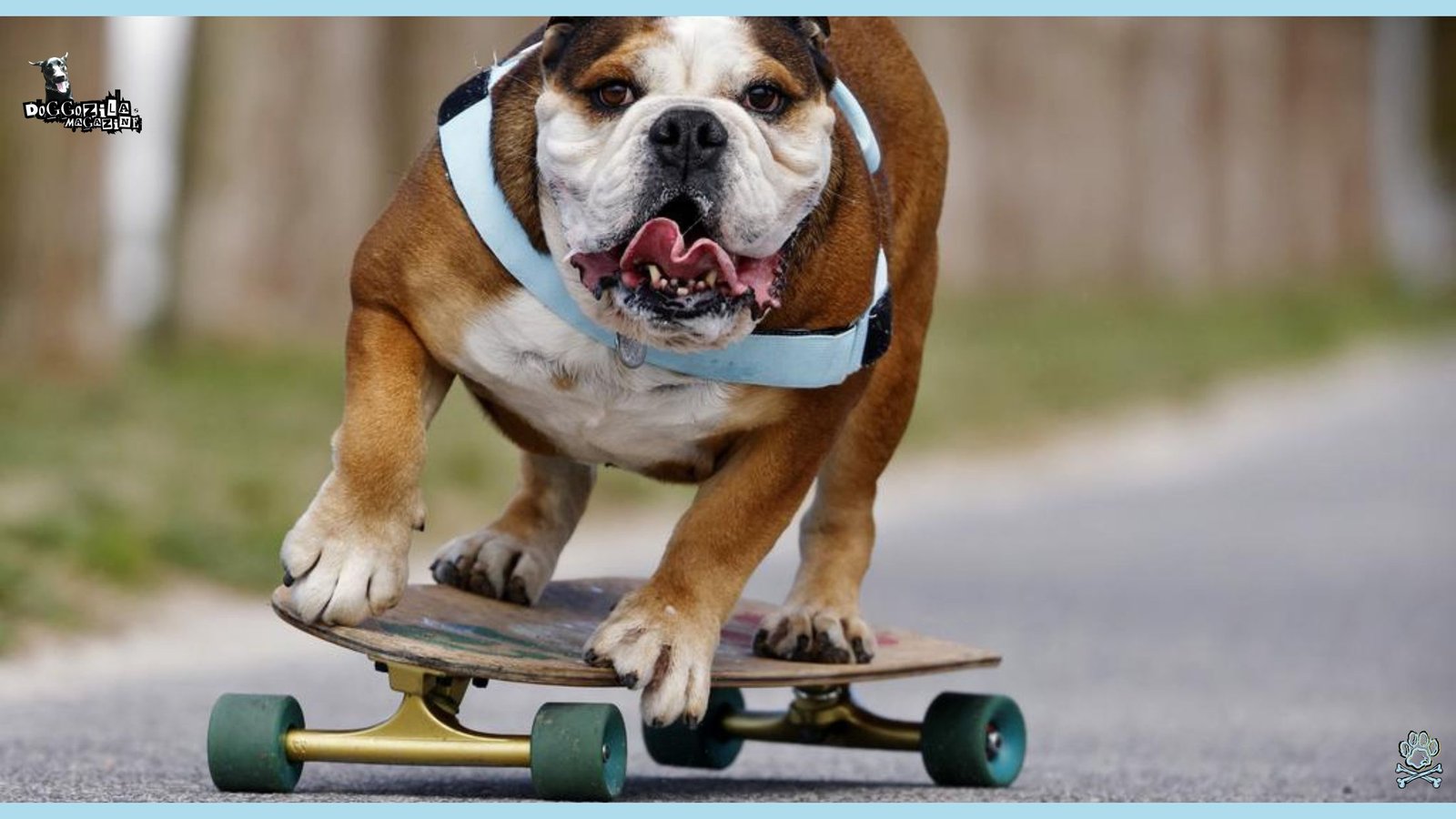
STOPPING AND SAFETY: NON-NEGOTIABLES WHEN YOU TEACH YOUR DOG HOW TO RIDE A SKATEBOARD
Moving is fun, but stopping is essential! Teaching reliable stopping methods is arguably more important than going fast. This is fundamental for safety around obstacles, people, or traffic. We need multiple strategies.
Teach your dog the “Bail” Command: Safe Exits and Avoiding Wipeouts when riding a skateboard
“Bail” means “Get off the board safely right now.” This is your emergency brake. Teach this separately off the board first. Toss a treat away from the stationary board and say “Bail!” as they jump off to get it. Repeat until they associate the command with leaping off.
Then, practice while they are just standing on the stationary board – say “Bail,” lure/toss a treat off, and reward the jump. Finally, practice during very slow, controlled rolls. To teach your dog to ride a skateboard safely mandates a reliable “Bail.” This command is vital if they lose control, head towards danger, or simply get spooked.
Reward heavily for quick, clean exits. It gives you peace of mind knowing they can dismount safely on command. Practice bailing to both sides. Make it a fun, rewarding game in itself. A dog who knows how to bail confidently is much less likely to panic and crash.
Natural Stopping Methods: Using Friction, Gravity, and Paw Power
Beyond the emergency “Bail,” dogs need to learn how to stop the board themselves. The simplest method is letting the board naturally slow down due to friction on flat ground or rolling uphill. Practice on gentle inclines where they roll up and stop.
Encourage them to step off with their front paws to drag and stop (like a rudimentary foot brake) – you can lure them forward off the board onto grass or rougher pavement. To teach your dog to ride a skateboard effectively includes mastering these passive stops. Design practice runs that naturally end in a safe stopping zone (like grass).
Praise and reward calm stopping. Some dogs learn to shift their weight backwards slightly to slow down. Understand that controlled stopping takes time and coordination to master; it’s often the last skill to fully develop. Always prioritize environments where uncontrolled rolls won’t lead to danger. Consistent practice in safe zones builds their stopping intuition.
🔑 Key Points: Reliable stopping is paramount for safety. Teach a solid “Bail” command off the board first, then practice it during slow rolls as an emergency exit. Encourage natural stopping methods like letting friction slow the board on flat ground, rolling uphill to stop, or teaching them to step off with their front paws to drag. Always practice in environments where uncontrolled stops aren’t dangerous.
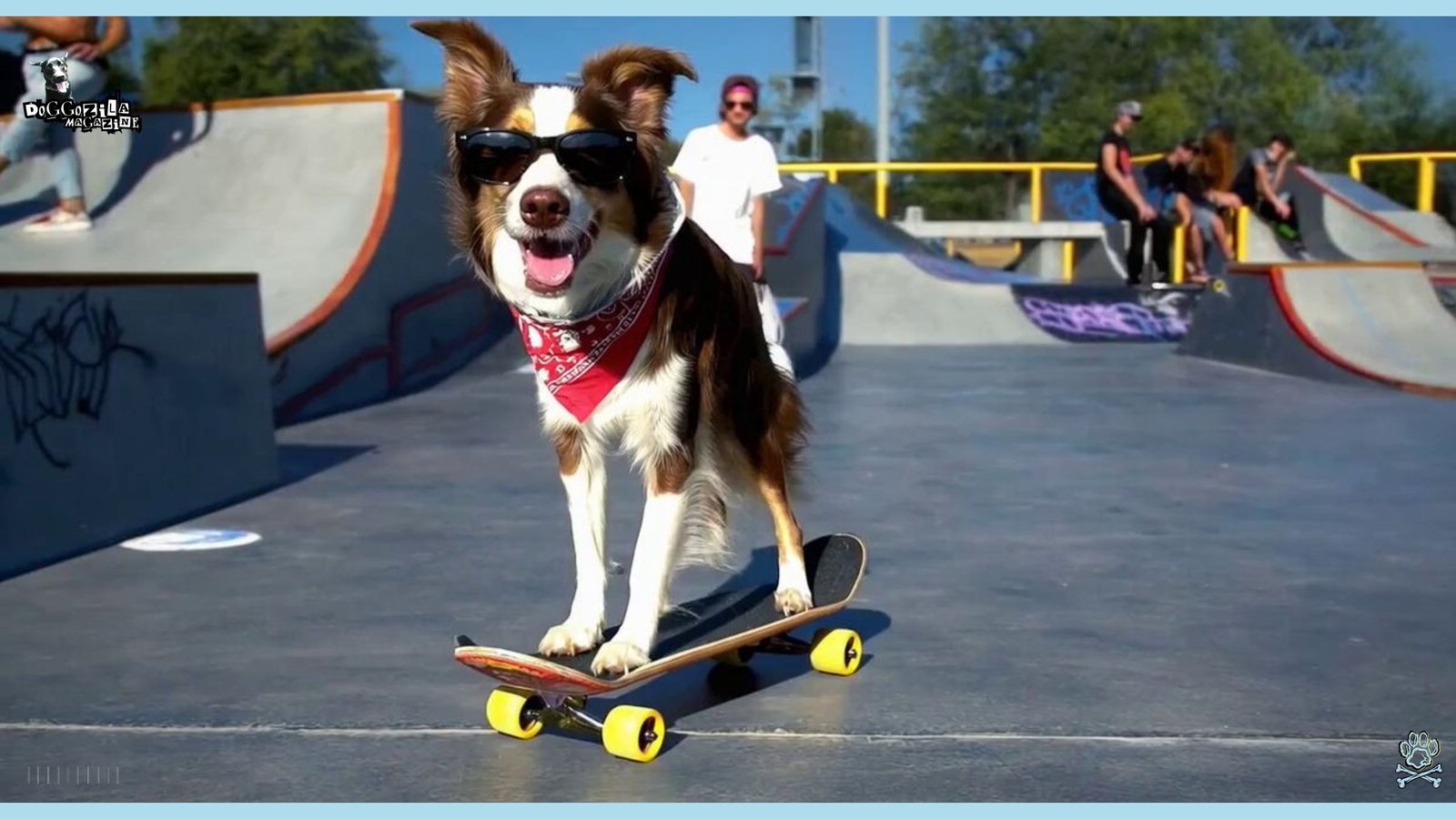
LEVELING UP: HOW TO TEACH YOUR DOG TO SKATEBOARD WITH TRICKS AND STYLE
Once the fundamentals are solid, the real fun begins! Adding simple tricks showcases their skills and keeps training engaging. Always prioritize safety and build complexity very gradually.
Basic Maneuvers: Gentle Turns and Navigating Slight Curves
Start introducing gentle turns only after they confidently ride straight. Use luring or your body position to guide them into wide, sweeping arcs. Place cones or markers to create simple slalom courses. Reward looking in the direction of the turn and subtle weight shifts. So, to teach your dog how ride a skateboard with style starts with mastering controlled direction changes.
Keep turns wide and gradual initially; sharp turns require advanced balance and can cause spills. Practice both left and right turns. Focus on smooth, flowing movements rather than jerky changes. Turns add a whole new dimension and make skate sessions much more dynamic and enjoyable for both of you. Celebrate every successful navigation!
Confidence on Different Terrains: Pavement, Boardwalks, and Smooth Trails
Once they’re a pro on your practice pavement, explore new surfaces! Smooth boardwalks offer a fun coastal vibe. Hard-packed dirt or gravel paths (ensure no sharp rocks!) provide different textures and slight resistance. To teach your dog to ride a skateboard adventurously involves gradual exposure. Introduce new terrains slowly. Let them inspect the surface first.
Start with short sessions. Different surfaces affect speed, noise, and vibration – praise calmness. Always check pavement temperature in summer to prevent burned paws. Expanding their terrain repertoire keeps the activity exciting and mentally stimulating. It’s about shared exploration and conquering new challenges together.
🔑 Key Points: Add flair only after mastering fundamentals. Introduce wide, gentle turns using luring or body guidance, progressing to simple slalom courses. Gradually expose your confident skater to new, dog-safe terrains like smooth boardwalks or hard-packed trails, praising calmness as they adapt to different surfaces, textures, and sounds.
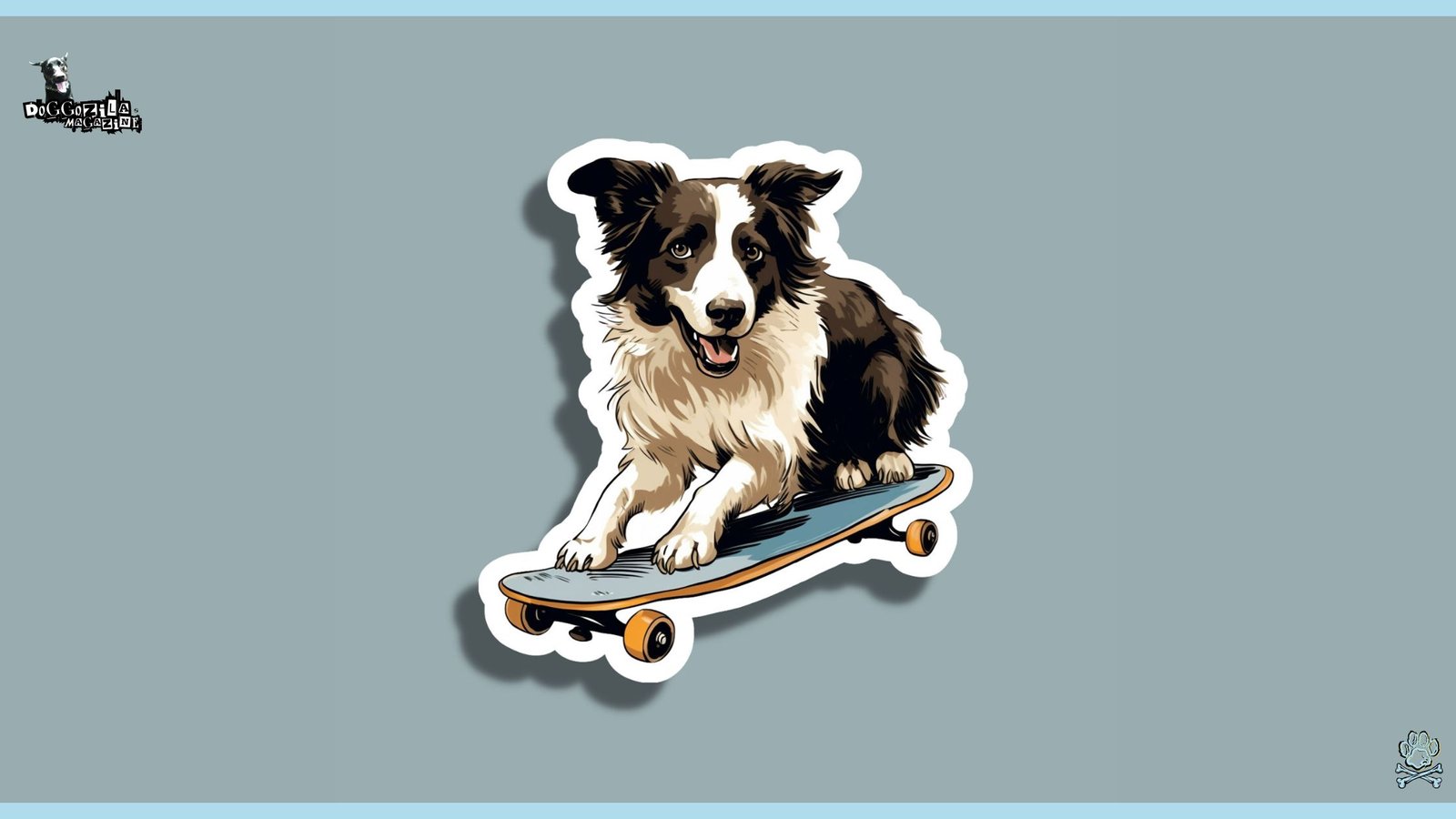
THE RAD ROUTINE: MAINTAINING SKILLS AND HAVING A BLAST
Skateboarding is a perishable skill for pups too! Integrate it into your routine to keep their skills sharp and their enthusiasm high. Make it a highlight of their week.
Keeping Sessions Short, Sweet, and Rewarding: Avoiding Burnout
Dogs thrive on short, positive bursts of activity. Aim for 5-15 minute skate sessions, max. End while they’re still eager and having fun, not exhausted or frustrated. Always finish with a huge success and jackpot reward. To teach your dog to ride a skateboard sustainably means prioritizing quality over quantity. Mix skate sessions with other activities like walks or play.
Watch for signs of fatigue or disinterest (slowing down, avoiding the board, lagging) – that’s your cue to stop. Keep the vibe light, playful, and pressure-free. Consistent, joyful short sessions build and maintain skills far better than infrequent, long, grueling ones. This is bonding time, not boot camp!
Joining the Pack: Finding Canine Skate Communities and Safe Spots
Skateboarding with your dog is even more fun with friends! Seek out local dog parks with smooth paths or inquire about dog-friendly skate spots (some skateparks have designated times or areas). Connect with other “skate dog” owners online or locally. So, to teach your dog to ride a skateboard socially involves ensuring they are comfortable and non-reactive around other dogs and boards before group sessions.
Start with parallel skating at a distance. Organized meetups can be fantastic for motivation and sharing tips. Always prioritize safety and be mindful of other park users. Seeing other dogs skate can be hugely inspiring for your pup! Celebrate the unique bond you’ve built through this radical activity.
Gear Up and Roll Out!
Teaching your dog to ride a skateboard is a journey filled with laughter, occasional wobbles, and immense pride. It’s not just about the trick; it’s about communication, trust, and sharing an incredibly cool adventure with your best friend. By following these steps patiently, prioritizing safety and positivity, and celebrating every tiny victory, you’ll unlock a whole new level of fun.
Remember the core of how to teach your dog to ride a skateboard: make it rewarding, keep it safe, and let their confidence grow at their own pace. Soon enough, you’ll be the talk of the town, cruising alongside your four-legged skate prodigy. Now grab that board, some treats, and get ready to roll! Share your skate dog adventures online – the world needs more rad pups on wheels!
Final Thoughts About How To Teach Your Dog To Ride A Skateboard
Keep skateboarding fun and sustainable. Maintain skills with short, positive sessions (5-15 mins), always ending on a high note with rewards to avoid burnout. Integrate skating into regular routines alongside other activities. Consider connecting with other “skate dog” owners for safe group sessions or meetups, fostering social enjoyment after ensuring your dog is comfortable around others.

